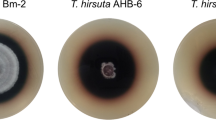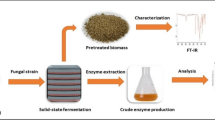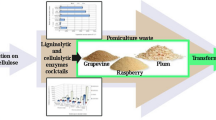Abstract
One of the main wastes that created environmental troubles is lignocellulosics such as fruit pulps collected in huge amounts from food industry. Peach wastes were utilized as the substrates raise ligninocellulolytic enzymes productions, namely manganese peroxidase (MnP), lignin peroxidase (LiP), carboxymethyl cellulase (CmCase), xylanase, exoglucanase, β-glucosidase (BGLA), by Pleurotus eryngii. The effects of different concentrations with different compounds, copper, iron, Tween 80, ammonium nitrate and manganese on productions of ligninocellulolytic enzymes were investigated contingent on incubation time. The optimal productions of ligninocellulolytic enzymes were attained by 5.0 g peach waste and 70 µM Cu2+, 18 µM Fe2+, 4.0 gL−1 ammonium nitrate, 250 µM Mn2+, 0.025% (v/v) Tween 80 qua the inductivers. According to the results under optimized conditions, 6.51-, 9.52-, 1.86-, 3.17-, 1.06-, and 2.73-fold boosts were achieved for lignocellulolytic enzyme activities of MnP, LiP, CMCase, Xylanase, exoglucanase, BGLA, respectively. This study is important with regard to succeed the improvement of six-lignocellulolytic enzymes activities utilizing various inducers.
Graphical abstract











Similar content being viewed by others
References
Adrio JL, Demain AL (2014) Microbial enzymes: tools for biotechnological processes. Biomolecules 4(1):117–139
Akpinar M, Ozturk Urek R (2012) Production of ligninolytic enzymes by solid-state fermentation using Pleurotus eryngii. Prep Biochem Biotechnol 42(6):582–597
Akpinar M, Ozturk Urek R (2014) Extracellular ligninolytic enzymes production by Pleurotus eryngii on agroindustrial wastes. Prep Biochem Biotechnol 44(8):772–781
Akpinar M, Ozturk Urek R (2017a) Peach and cherry agroindustrial wastes: new and economic sources for the production of lignocellulolytic enzymes. Acta Chim Slov 64(2):422–430
Akpinar M, Ozturk Urek R (2017b) Induction of fungal laccase production under solid state bioprocessing of new agroindustrial waste and its application on dye decolorization. 3 Biotech 7(2):1–10
Akpinar M, Ozturk Urek R (2020) Decolorization and degradation potential of enhanced lignocellulolytic enzymes production by Pleurotus eryngii using cherry waste from industry. Biotechnol Appl Biochem 67:760–773
An Q, Wu XJ, Han ML, Cui BK, He SH, Dai YC et al (2016) Sequential solid-state and submerged cultivation of the white rot fungus Pleurotus ostreatus on biomass and the activity of lignocellulolytic enzymes. BioResources 11(4):8791–8805
Arora S, Rani R, Ghosh S (2018) Bioreactors in solid state fermentation technology: design, applications and engineering aspects. J Biotechnol 269:16–34
Asgher M, Khan SW, Bilal M (2016) Optimization of lignocellulolytic enzyme production by Pleurotus eryngii WC 888 utilizing agro-industrial residues and bio-ethanol production. Rom Biotechnol Lett 21(1):11133–11143
Astudillo-Neira R, Muñoz-Nuñez E, Quiroz-Carreno S, Avila-Stagno J, Alarcon-Enos J (2022) Bioconversion in ryegrass-fescue hay by Pleurotus ostreatus to increase their nutritional value for ruminant. Agriculture 12(4):534
Baldrian P (2003) Interactions of heavy metals with white-rot fungi. Enzyme Microb Technol 32(1):78–91
Baldrian P, Valášková V, Merhautová V, Gabriel J (2005) Degradation of lignocellulose by Pleurotus ostreatus in the presence of copper, manganese, lead and zinc. Res Microbiol 156:670–676
Behera SS, Ray RC (2016) Solid state fermentation for production of microbial cellulases: recent advances and improvement strategies. Int J Biol Macromol 86:656–669
Belhamiche N, Duchiron F, Benallaoua S (2021) Effect of some agro-ındustrial residues on mycelial growth and production of lignocellulolytic enzymes by a fungus native to Algerian forest. Environ Pollut 10:11–20
Bonnarme P, Jeffries TW (1990) Mn (II) regulation of lignin peroxidases and manganese-dependent peroxidases from lignin-degrading white rot fungi. Appl Environ Microbiol 56(1):210–217
Bradford MM (1976) A rapid and sensitive method for the quantitation of microgram quantities of protein utilizing the principle of protein-dye binding. Anal Biochem 72(1–2):248–254
Caroca E, Elorrieta M, Palma C, Navia D, Lebrero R, Carvajal A (2022) Lignocellulosic residue valorization in a sequential process of solid-state fermentation and solid substrate anaerobic digestion. J Chem Technol Biotechnol 97:1575–1584
Chakravarty G (2016) Evaluation of fruit wastes as substrates for the production of biogas. Ann Biol Res 7(3):25–28
Deng GF, Shen C, Xu XR, Kuang RD, Guo YJ, Zeng LS et al (2012) Potential of fruit wastes as natural resources of bioactive compounds. Int J Mol Sci 13(7):8308–8323
Di Donato P, Fiorentino G, Anzelmo G, Tommonaro G, Nicolaus B, Poli A (2011) Re-use of vegetable wastes as cheap substrates for extremophile biomass production. Waste Biomass Valor 2:103–111
Dunn LL, Rahmanto YS, Richardson DR (2007) Iron uptake and metabolism in the new millennium. Trends Cell Biol 17:93–100
Dursun D, Dalgıç AC (2018) Tarımsal-endüstriyel atıklardan katma değeri yüksek pigmentlerin biyoüretimi. Acad Food J 16(2):205–209
Eriksson T, Börjesson J, Tjerneld F (2002) Mechanism of surfactant effect in enzymatic hydrolysis of lignocellulose. Enzyme Microb Technol 31(3):353–364
FAO Statistics Data (2014) Available from: www.fao.org/faostat/en/data. Accessed 2017 June 26
Farinas CS (2015) Developments in solid-state fermentation for the production of biomass-degrading enzymes for the bioenergy sector. Renew Sust Energ Rev 52:179–188
Gassara F, Brar SK, Tyagi RD, John RP, Verma M, Valero JR (2011) Parameter optimization for production of ligninolytic enzymes using agro-industrial wastes by response surface method. Biotechnol Bioprocess Eng 16(2):343–351
Gnanasalomi VDV, Gnanadoss JJ (2019) Laccase production by Myrothecium gramineum and its optimization under solid state fermentation using cowpea pod as substrate. J Appl Biol Biotechnol 7(02):59–63
Gold MH, Alic M (1993) Molecular biology of the lignin-degrading basidiomycete Phanerochaete chrysosporium. Microbiol Mol Biol Rev 57(3):605–622
Guillén Y, Machuca A (2008) The effect of copper on the growth of wood-rotting fungi and a blue-stain fungus. World J Microbiol Biotechnol 24(1):31–37
Gurung N, Ray S, Bose S, Rai V (2013) A broader view: microbial enzymes and their relevance in industries, medicine, and beyond. BioMed Res Int 2013:1–18
Hailei W, Ping L, Yuhua Y, Yufeng L (2015) Overproduction of laccase from a newly isolated Ganoderma lucidum using the municipal food waste as main carbon and nitrogen supplement. Bioprocess Biosyst Eng 38(5):957–966
Hernández CA, Sandoval N, Mallerman J, García-Pérez JA, Farnet AM, Perraud-Gaime I et al (2015) Ethanol induction of laccase depends on nitrogen conditions of Pycnoporus sanguineus. Electron J Biotechnol 18(4):327–332
Hoa HT, Wang CL (2015) The effects of temperature and nutritional conditions on mycelium growth of two oyster mushrooms (Pleurotus ostreatus and Pleurotus cystidiosus). Mycobiology 43(1):14–23
Iandolo D, Piscitelli A, Sannia G, Faraco V (2011) Enzyme production by solid substrate fermentation of Pleurotus ostreatus and Trametes versicolor on tomato pomace. Appl Biochem Biotechnol 163(1):40–51
Ibrahim UK, Kamarrudin N, Suzihaque MUH, Hashib SA (2017) Local fruit wastes as a potential source of natural antioxidant: an overview. IOP Conf Ser Mater Sci Eng 206:012040
Kumaran S, Sastry CA, Vikineswary S (1997) Laccase, cellulase and xylanase activities during growth of Pleurotus sajor-caju on sagohampas. World J Microbiol Biotechnol 13(1):43–49
Kuwahara M, Glenn JK, Morgan MA, Gold MH (1984) Separation and characterization of two extracelluar H2O2-dependent oxidases from ligninolytic cultures of Phanerochaete chrysosporium. FEBS Lett 169(2):247–250
Leite P, Silva C, Salgado JM, Belo I (2019) Simultaneous production of lignocellulolytic enzymes and extraction of antioxidant compounds by solid-state fermentation of agro-industrial wastes. Ind Crops Prod 137:315–322
Liguori R, Ionata E, Marcolongo L, Vandenberghe LPDS, La Cara F, Faraco V (2015) Optimization of Arundo donax saccharification by (Hemi) cellulolytic enzymes from Pleurotus ostreatus. BioMed Res Int 2015:1–14
Locatelli GO, Finkler L, Finkler CL (2019) Orange and passion fruit wastes characterization, substrate hydrolysis and cell growth of Cupriavidus necator, as proposal to converting of residues in high value added product. An Acad Bras Cienc 91(1):e20180058
Luz JMRD, Nunes MD, Paes SA, Torres DP, Silva MDCSD, Kasuya MCM (2012) Lignocellulolytic enzyme production of Pleurotus ostreatus growth in agroindustrial wastes. Braz J Microbiol 43(4):1508–1515
Mäkelä MR, Lundell T, Hatakka A, Hilden K (2013) Effect of copper, nutrient nitrogen, and wood-supplement on the production of lignin-modifying enzymes by the white-rot fungus Phlebia radiata. Fungal Biol 117(1):62–70
Marques GL, Silva TP, Lessa OA, de Brito AR, Reis NS et al (2019) Production of xylanase and endoglucanase by solid-state fermentation of jackfruit residue. Rev Mex Ing Quím 18(2):673–680
Masutti D, Borgognone A, Scardovi F, Vaccari C, Setti L (2015) Effects on the enzymes production from different mixes of agro-food wastes. Chem Eng Trans 43:487–492
Mehboob N, Asad MJ, Asgher M, Gulfraz M, Mukhtar T, Mahmood RT (2014) Exploring thermophilic cellulolytic enzyme production potential of Aspergillus fumigatus by the solid-state fermentation of wheat straw. Appl Biochem Biotechnol 172(7):3646–3655
Miller GL (1959) Use of dinitrosalicylic acid reagent for determination of reducing sugar. Anal Chem 31(3):426–428
Naik BS, Abrar S, Krishnappa M (2019) Industrially important enzymes from fungal endophytes. In: Yadav AN et al (eds) Recent advancement in white biotechnology through fungi. Springer, Cham, pp 263–280
Öztürk Ürek R, Pazarlioǧlu NK (2005) Production and stimulation of manganese peroxidase by immobilized Phanerochaete chrysosporium. Process Biochem 40(1):83–87
Panda SK, Mishra SS, Kayitesi E, Ray RC (2016) Microbial-processing of fruit and vegetable wastes for production of vital enzymes and organic acids: Biotechnology and scopes. Environ Res 146:161–172
Perez J, Jeffries TW (1992) Roles of manganese and organic acid chelators in regulating lignin degradation and biosynthesis of peroxidases by Phanerochaete chrysosporium. Appl Environ Microbiol 58(8):2402–2409
Plazzotta S, Manzocco L, Nicoli MC (2017) Fruit and vegetable waste management and the challenge of fresh-cut salad. Trends Food Sci Technol 63:51–59
Prasher IB, Chauhan R (2015) Effect of carbon and nitrogen sources on the growth, reproduction and ligninolytic enzymes activity of Dictyoarthrinium synnematicum Somrith. Adv Zool Bot 3(2):24–30
Rodríguez R, Jiménez A, Guillén R, Heredia A, Fernández-Bolaños J (1999) Postharvest changes in white asparagus cell wall during refrigerated storage. J Agric Food Chem 47(9):3551–3557
Rodríguez R, Jimenez A, Fernández-Bolanos J, Guillen R, Heredia A (2006) Dietary fibre from vegetable products as source of functional ingredients. Trends Food Sci Technol 17(1):3–15
Rodríguez Couto S (2008) Exploitation of biological wastes for the production of value-added products under solid-state fermentation conditions. Biotechnol J 3(7):859–870
Sagar NA, Pareek S, Sharma S, Yahia EM, Lobo MG (2018) Fruit and vegetable waste: bioactive compounds, their extraction, and possible utilization. Compr Rev Food Sci Food Saf 17(3):512–531
Saha AK, Brewer CF (1994) Determination of the concentrations of oligosaccharides, complex type carbohydrates, and glycoproteins using the phenol-sulfuric acid method. Carbohydr Res 254:157–167
Sazanova K, Osmolovskaya N, Schiparev S, Yakkonen K, Kuchaeva L, Vlasov D (2015) Organic acids induce tolerance to zinc-and copper-exposed fungi under various growth conditions. Curr Microbiol 70(4):520–527
Sharma M, Kumar Bajaj B (2017) Optimization of bioprocess variables for production of a thermostable and wide range pH stable carboxymethyl cellulase from Bacillus subtilis MS 54 under solid state fermentation. Environ Prog Sustain Energy 36(4):1123–1130
Singh R, Kumar M, Mittal A, Mehta PK (2016) Microbial enzymes: industrial progress in 21st century. 3 Biotech 6(174):1–15
Soccol CR, da Costa ESF, Letti LAJ, Karp SG, Woiciechowski AL, de Souza Vandenberghe LP (2017) Recent developments and innovations in solid state fermentation. Biotechnol Res Innov 1(1):52–71
Stajić M, Persky L, Friesem D, Hadar Y, Wasser SP, Nevo E et al (2006) Effect of different carbon and nitrogen sources on laccase and peroxidases production by selected Pleurotus species. Enzyme Microb Technol 38(1):65–73
Stenmarck A, Jensen C, Quested T et al (2016) Estimates of European food waste levels. Fusions EU Project Report Stockholm, Sweden (ISBN 978–91–88319–01–29)
Tien M, Kirk TK (1988) Lignin peroxidase of Phanerochaete chrysosporium. Meth Enzymol 161:238–249
Vasconcellos VM, Tardioli PW, Giordano RLC, Farinas CS (2016) Addition of metal ions to a (hemi) cellulolytic enzymatic cocktail produced in-house improves its activity, thermostability, and efficiency in the saccharification of pretreated sugarcane bagasse. New Biotechnol 33(3):331–337
World Farmers Organisation (2014) Available from http://www.wfo-oma.com/news/global-production-of-fruits-and-vegetables-increased-by-9-4.html (last accessed on 06.08.15)
Zhao X, Huang X, Yao J, Zhou Y, Jia R (2015) Fungal growth and manganese peroxidase production in a deep tray solid-state bioreactor, and in vitro decolorization of poly R-478 by MnP. J Microbiol Biotechnol 25(6):803–813
Zinat M, Tanzir A, Shahdat H, Abdullah AM, Harun OR, Tabassum M (2013) Use of Pleurotus sajor-caju in upgrading green jute plants and jute sticks as ruminant feed. J Biosci Biotechnol 2(2):01–107
Acknowledgements
We are thankful to Scientific Research Project of Dokuz Eylül University (Project No: 2012.KB. FEN.078). We also are thankful to Dimes, Izmir for providing lignocellulosic substrates for research.
Author information
Authors and Affiliations
Corresponding author
Ethics declarations
Conflict of interest
All authors have no any conflict of interest.
Ethical approval
Not applicable in current study.
Consent to participate
Not applicable in current study.
Consent for publication
Not applicable in current study.
Additional information
Publisher's Note
Springer Nature remains neutral with regard to jurisdictional claims in published maps and institutional affiliations.
Rights and permissions
About this article
Cite this article
Akpinar, M., Ozturk Urek, R. Direct utilization of peach wastes for enhancements of lignocellulolytic enzymes productions by Pleurotus eryngii under solid-state fermentation conditions. Chem. Pap. 76, 6699–6712 (2022). https://doi.org/10.1007/s11696-022-02356-0
Received:
Accepted:
Published:
Issue Date:
DOI: https://doi.org/10.1007/s11696-022-02356-0




